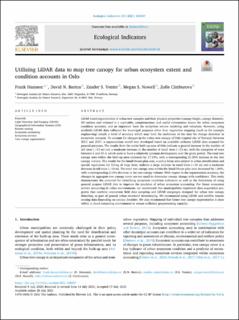| dc.contributor.author | Hanssen, Frank Ole | |
| dc.contributor.author | Barton, David Nicholas | |
| dc.contributor.author | Venter, Zander | |
| dc.contributor.author | Nowell, Megan Sara | |
| dc.contributor.author | Cimburova, Zofie | |
| dc.coverage.spatial | Oslo, Norway | en_US |
| dc.date.accessioned | 2022-03-25T08:28:03Z | |
| dc.date.available | 2022-03-25T08:28:03Z | |
| dc.date.created | 2021-08-26T11:48:20Z | |
| dc.date.issued | 2021 | |
| dc.identifier.issn | 1470-160X | |
| dc.identifier.uri | https://hdl.handle.net/11250/2987546 | |
| dc.description.abstract | LiDAR-based segmentation of urban tree canopies and their physical properties (canopy height, canopy diameter, 3D surface and volume) is a replicable, complementary and useful information source for urban ecosystem condition accounts, and an important basis for ecosystem service modeling and valuation. However, using available LiDAR data collected for municipal purposes other than vegetation mapping (such as for example engineering) entails a level of accuracy which may limit the usefulness of the data for change detection in ecosystem accounts. To account for changes in the urban tree canopy of Oslo (capital city of Norway) between 2011 and 2017, a segmentation model was developed based on available airborne LiDAR data scanned for general purposes. The results from the entire built-up area of Oslo indicate a general increase in the number of tall trees (>15 m) and a moderate increase in the number of small trees (<15 m), with the exception of trees between 6 and 10 m which seem to have a relatively constant development over the given period. The total tree canopy area within the built-up area increased by 17.15%, with a corresponding 21.35% increase in the tree canopy volume. The results for the Small House plan area, a policy focus area subject to urban densification and special regulations for felling of large trees, indicate a large increase in small trees (<10 m) and a moderate decrease in tall trees (>10 m). The total tree canopy area within the Small House plan area decreased by 1.04%, with a corresponding 2.13% decrease in the tree canopy volume. With respect to the segmentation accuracy, the changes in aggregate tree canopy cover are too small to determine canopy change with confidence. This study demonstrates the potential for identifying ecosystem condition indicators as well as the limitations of using general purpose LiDAR data to improve the precision of urban ecosystem accounting. For future ecosystem service accounting in urban environments, we recommend that municipalities implement data acquisition programs that combine concurrent field data sampling and LiDAR campaigns designed for urban tree canopy detection, as part of general urban structural inventorying. We recommend using LiDAR and satellite remote sensing data depending on canopy densities. We also recommend that future tree canopy segmentation is done within a cloud-computing environment to ensure sufficient geoprocessing capacity. | en_US |
| dc.language.iso | eng | en_US |
| dc.rights | Navngivelse 4.0 Internasjonal | * |
| dc.rights.uri | http://creativecommons.org/licenses/by/4.0/deed.no | * |
| dc.subject | Geografiske informasjonssystemer | en_US |
| dc.subject | Geographical information systems | en_US |
| dc.subject | Lidar | en_US |
| dc.subject | Lidar | en_US |
| dc.subject | Økosystemregnskap | en_US |
| dc.subject | Ecosystem accounting | en_US |
| dc.subject | Økosystemtjenester | en_US |
| dc.subject | Ecosystem services | en_US |
| dc.title | Utilizing LiDAR data to map tree canopy for urban ecosystem extent and condition accounts in Oslo | en_US |
| dc.type | Peer reviewed | en_US |
| dc.type | Journal article | en_US |
| dc.description.version | publishedVersion | en_US |
| dc.rights.holder | © 2021 The Authors | en_US |
| dc.subject.nsi | VDP::Matematikk og naturvitenskap: 400 | en_US |
| dc.subject.nsi | VDP::Mathematics and natural scienses: 400 | en_US |
| dc.source.volume | 130 | en_US |
| dc.source.journal | Ecological Indicators | en_US |
| dc.identifier.doi | 10.1016/j.ecolind.2021.108007 | |
| dc.identifier.cristin | 1928922 | |
| dc.relation.project | Norges forskningsråd: 255156 | en_US |
| cristin.ispublished | true | |
| cristin.fulltext | original | |
| cristin.qualitycode | 1 | |

